Читать книгу End-to-end Data Analytics for Product Development - Chris Jones - Страница 25
Stat Tool 1.12 Basic Concepts of Statistical Inference
ОглавлениеAfter describing important characteristics of sample data through descriptive statistics, the second step of a statistical analysis is usually inferential analysis, where sample findings are generalized to the referring population.
Inferential techniques use descriptive statistics such as:
| sample mean “ ” | sample proportion “p” | sample standard deviation “S” |
to draw conclusions about the corresponding unknown quantities of the population, called parameters:
| population mean: “μ” | population proportion “π” | population standard deviation “σ” |
Note that it is standard to use Greek letters for certain parameters, such as μ to stand for a population mean, σ for a population standard deviation, σ2 for a population variance, and π for a proportion of statistical units having a characteristic of interest.
A statistic (mean, proportion, variance) describes a characteristic of the sample (central tendency, variability, shape of data) and is known.
A parameter (mean, proportion, variance) describes a characteristic of the population (central tendency, variability, shape of data) and is unknown.
Statistical inference uses sample data to draw conclusions about a population with a known level of risk. In general, statistical inference proceeds as follows:
1 We are interested in a population.
2 We identify parameters of that population that will help us understand it better.
3 We take a random sample and compute sample statistics.
4 Through inferential techniques, we use the sample statistics to infer facts about the population parameters of interest.
